History of lions in Europe
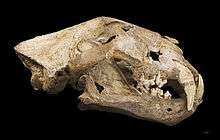
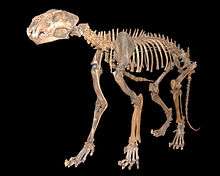
The history of lions in Europe is based on fossils of Pleistocene and Holocene lions excavated in Europe since the early 19th century.[1][2] Historical literature such as the Iliad of ancient Greece features lion similes.[3]
The first lion fossil was excavated in southern Germany and described by Georg August Goldfuss under Felis spelaea, which probably dates to the Würm glaciation and is 191,000 to 57,000 years old.[4] Older lion skull fragments were excavated in Germany and described by Wilhelm von Reichenau under Felis fossilis in 1906.[5] These are estimated at between 621,000 and 533,000 years old.[6]
The modern lion inhabited parts of Southern Europe since the early Holocene. Its diet probably included aurochs, red deer, tarpan, wild boar, and other herbivores.[7][8]
Characteristics
Bone fragments of fossil spelaea lions indicate that they were bigger than the modern lion and had less specialized lower teeth, reduced lower premolars and smaller incisors.[6]
As indicated by the numerous art depictions, modern lions in the Balkans despite the fact of cooler climate, had less developed mane, lacking abdominal and lateral manes and ulnar hair. Οn the contrary, lions from Transcaucasia exhibited all these features.[8]
Distribution
Fossil records
Lion fossils were excavated in Spain, Portugal, France, Italy, Belgium, United Kingdom, Germany, Poland, Czech Republic, Hungary and Russia.[6][9][10] The oldest fossils excavated near Pakefield in the United Kingdom are estimated at 680,000 years old and represent Panthera leo fossilis.[11]
Late Pleistocene Panthera spelaea bone fragments date to between the Weichselian glaciation and the Holocene, and are between 109,000 and 14,000 years old.[9] This lion was widely distributed from the Iberian peninsula, Southeast Europe, across most of northern Eurasia into Alaska. In Eurasia, it became extinct between 14,900 and 14,100 years ago, and survived in Beringia until 13,800 to 13,300 years ago.[12]
Subfossil records
The earliest subfossil lion remains to date were excavated in Basque Country and are about 9,600–7,000 years old, dating to the Boreal period.[21] There are doubts if this was a modern lion or a late surviving spelaea cave lion.[22]
A neolithic lion tooth fragment representing the Atlantic Period was found in Karanovo, Bulgaria, and is estimated 6,000 years old.[23] In Greece lions first appeared around 6,500-6,000 years ago as indicated by a front leg bone found in Philippi.[2] Bone fragments of the modern lion were excavated in Hungary and in Ukraine's Black Sea region, which are estimated at around 5,500 to 3,000 years old.[24] Remains were also found in Albania, Romania and European Turkey.[15]
Historic range of Panthera leo
In Eastern Europe, the lion inhabited part of the Balkan peninsula up to Hungary and Ukraine during the Neolithic period.[25][26] It survived in Bulgaria until the 4th or 3rd century BC, and in mainland Greece until about 100 AD.[22][27] It became extinct in the Peloponnese around 1,000 BC.[2][28] It disappeared from Macedonia around the first century AD, and in Thessaly in the 4th century AD.[25][26][29][30][31] Possibly it survived longer farther south. In the 4th century AD, Themistius regrets that in his time the lion disappeared in Thessaly and no more lions could be furnished for beast-shows.[3][20]
In Transcaucasia, the lion was present until the 10th century. The peak of its historic range covered all of the plains and foothills of eastern Transcaucasia westward almost to Tbilisi. Northwards, its range extended through the eastern Caucasus, from the Apsheron Peninsula to the mouth of the Samur River near the current Azerbaijan-Russia border, extending to the Araks river. From there, the boundary of its range narrowly turned east to Yerevan, with its northern boundary then extending westward to Turkey.[8]
In culture
Lions feature in ancient Greek mythology and writings, including the myth of the Nemean lion, which was believed to be a supernatural lion that occupied the sacred town of Nemea in the Peloponnese.[32] Homer mentioned lions 45 times in his poems, but this could have been due to his experience in Asia Minor.[13]
Phalaecus, a tyrant of Amvrakia (modern-day Arta), was allegedly killed by a female lion due to his holding a newborn lion cub, after finding it on a hunting expedition.[33] According to Herodotus lions occurred between Achelous river and Nestus, being plentiful between Akanthos and Thermi. When Xerxes advanced near Echedorus in 480 BC, the troops' camels were attacked by lions.[27] Xenophon stated around 400 BC that lions were hunted around Mount Kissos, Pangaio, the Pindus mountains and elsewhere.[18] Aristotle in the 4th century BC provided some data on lion distribution, behaviour, breeding and also anatomy. According to him, lions were more numerous in North Africa than in Europe; they had approached towns, and attacked people only if they were old, or had poor dental health.[17] In the 2nd century AD, Pausanias referred to lion presence west of Nestus in Thrace, in the area of Abdera. He also referred to a story about Polydamas of Skotoussa, an Olympic winner in the 5th century BC, who allegedly used his bare hands to kill a lion on Thessalian part of Mount Olympus; and to one about Caranus of Macedon who according to the Macedonians, raised a trophy that was thrown down and destroyed by a lion that was rushing down from Mount Olympus.[19]
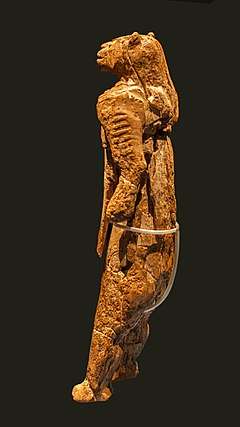
The Romans used Barbary lions from North Africa for lion-baiting,[34] and lions from Greece for gladiatorial games.[3][20]
.jpg)
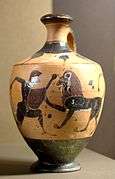
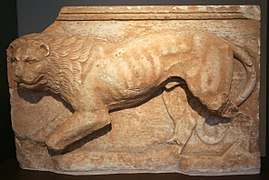 Lion sculpture, 4th century BC, Koropi, Greece
Lion sculpture, 4th century BC, Koropi, Greece Depiction of a hunting scene on a dagger found in Mycenae, Greece, 16th century BC
Depiction of a hunting scene on a dagger found in Mycenae, Greece, 16th century BC- Marble lion from Greece, mid-4th century BC
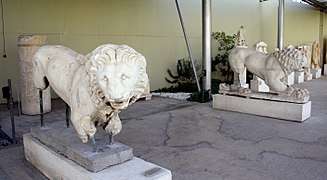 Depiction of the lion from the 4th century BC, Greece
Depiction of the lion from the 4th century BC, Greece Silver stater struck in Velia 334-300 BC depicting Athena wearing a Phrygian helmet decorated with a centaur and lion devouring prey
Silver stater struck in Velia 334-300 BC depicting Athena wearing a Phrygian helmet decorated with a centaur and lion devouring prey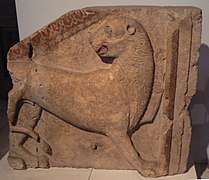
See also
References
- ↑ Diedrich, C.G. (2011). "The largest European lion Panthera leo spelaea (Goldfuss 1810) population from the Zoolithen Cave, Germany: specialised cave bear predators of Europe". Historical Biology. 23 (2–3): 271–311.
- 1 2 3 4 Bartosiewicz, L. (2009). "A Lion's share of attention: Archaeozoology and the historical record". Acta Archaeologica Academiae Scientiarum Hungaricae. 60 (1): 759–773.
- 1 2 3 4 Alden, M. (2005). "Lions in paradise: Lion similes in the Iliad and the Lion Cubs of IL. 18.318-22". The Classical Quarterly (55): 335–342.
- ↑ Diedrich, C.G. (2008). "The holotypes of the upper Pleistocene Crocuta crocuta spelaea (Goldfuss, 1823: Hyaenidae) and Panthera leo spelaea (Goldfuss, 1810: Felidae) of the Zoolithen Cave hyena den (South Germany) and their palaeo-ecological interpretation". Zoological Journal of the Linnean Society. 154 (4): 822–831.
- ↑ Reichenau, W. V. (1906). "Beiträge zur näheren Kenntnis der Carnivoren aus den Sanden von Mauer und Mosbach". Abhandlungen der Großherzoglichen Hessischen Geologischen Landesanstalt zu Darmstadt. 4 (2): 125.
- 1 2 3 Sabol, M. (2014). "Panthera fossilis (Reichenau, 1906) (Felidae, Carnivora) from Za Hájovnou Cave (Moravia, The Czech Republic): A Fossil Record from 1987-2007". Acta Musei Nationalis Pragae, Series B, Historia Naturalis. 70 (1–2): 59–70.
- ↑ Pocock, R. I. (1939). "Panthera leo". The Fauna of British India, including Ceylon and Burma. Mammalia. – Volume 1. London: Taylor and Francis Ltd. pp. 212–222.
- 1 2 3 Heptner, V. G.; Sludskiy, A. A. (1992) [1972]. "Lion". Mlekopitajuščie Sovetskogo Soiuza. Moskva: Vysšaia Škola [Mammals of the Soviet Union, Volume II, Part 2]. Washington DC: Smithsonian Institution and the National Science Foundation. pp. 83–95. ISBN 90-04-08876-8.
- 1 2 Marciszak, A. and Stefaniak, K. (2010). "Two forms of cave lion: Middle Pleistocene Panthera spelaea fossilis Reichenau, 1906 and Upper Pleistocene Panthera spelaea spelaea Goldfuss, 1810 from the Bisnik Cave, Poland". Neues Jahrbuch für Geologie und Paläontologie - Abhandlungen. 258 (3): 339–351.
- ↑ Baryshnikov, G. and Boeskorov, G. (2001). "The Pleistocene cave lion, Panthera spelaea (Carnivora, Felidae) from Yakutia, Russia". Cranium. 18 (1): 7–24.
- ↑ Lewis, M., Pacher, M., Turner, A. (2010). "The larger Carnivora of the West Runton Freshwater Bed". Quaternary International. 228: 116–135.
- ↑ Stuart, A.J., Lister, A.M. (2011). "Extinction chronology of the cave lion Panthera spelaea". Quaternary Science Reviews. 30 (17): 2329–2340.
- 1 2 Schnitzler, A. E. (2011). Past and present distribution of the North African-Asian lion subgroup: a review. Mammal Review 41: 220−243.
- ↑ Thomas, N.R. (2004). The Early Mycenaean Lion up to Date. Hesperia Supplements 33: 161−206.
- 1 2 Thomas, N.R. (2014). "A lion's eye view of the Greek Bronze Age". In Touchais, G.; Laffineur, R.; Rougemeont, F. Aegaeum 37. Annales liégeoises et PASPiennes d’archéologie égéenne. Leuven: Peeters. pp. 375−392.
- ↑ Herodotus ~430bC Book 7: Polymnia.
- 1 2 Αριστοτέλης, 4th century BCE: Των περί τα ζώα ιστοριών.
- 1 2 Ξενοφών, 5th-4th century BC: Κυνηγετικός
- 1 2 Frazer, J. G., ed. (1898). Pausanias's Description of Greece. London: Macmillan and Co.
- 1 2 3 Uhm, D.P. van (2016). The Illegal Wildlife Trade: Inside the World of Poachers, Smugglers and Traders. Switzerland: Springer International Publishing.
- ↑ Altuna, J. (1986). "The mammalian faunas from the prehistoric site of La Riera". In Straus, L. G.; Clark, G. La Riera Cave, Stone Age Hunter Gatherer Adaptations in Northern Spain. Arizona: Arizona State University Press. pp. 237–247.
- 1 2 Masseti, M. and Mazza, P.P.A. (2013). Western European Quaternary lions: new working hypotheses. Biological Journal of Linnean Society 109: 66-77.
- ↑ Bökönyi, S. (1989). "Erster vorläufiger Bericht über Tierknochenfunde der Karanovo-V-Besiedlung in Drama". Berichte der Römisch-Germanischen Kommission (70): 123–127.
- ↑ Sommer, R. S.; Benecke, N. (2006). "Late Pleistocene and Holocene development of the felid fauna (Felidae) of Europe: A review". Journal of Zoology. 269 (1): 7–19. doi:10.1111/j.1469-7998.2005.00040.x.
- 1 2 Douglas, N. (1927). Birds and Beasts of Greek Anthology. Florence: Norman Douglas.
- 1 2 Alden, M. (2005). "Lions in paradise: Lion Similes in the Iliad and the Lion Cubs of IL. 18.318-22". The Classical Quarterly (55): 335–342.
- 1 2 Guggisberg, C. A. W. (1975). "Lion Panthera leo (Linnaeus, 1758)". Wild Cats of the World. New York: Taplinger Publishing. pp. 138–179. ISBN 0-8008-8324-1.
- ↑ Schnitzler, A.E. (2011). Past and present distribution of the North African-Asian lion subgroup: a review. Mammal Review 41: 220-243.
- ↑ Bartosiewicz, L. (2008). "A Lion's Share of Attention: Archaeozoology and the historical record". Acta Archaeologica (2008): 759–773.
- ↑ Cohen, A. (2010). Art in the era of Alexander the Great: Paradigms of manhood and their cultural traditions, Cambridge University Press, pp. 68–69 ISBN 9780521769044.
- ↑ Uhm, D.P. van (2016). The Illegal Wildlife Trade: Inside the World of Poachers, Smugglers and Traders. Switzerland: Springer International Publishing.
- ↑ Hard, R. (2003). The Routledge Handbook of Greek Mythology: Based on HJ Rose's Handbook of Greek Mythology. London and New York: Routledge.
- ↑ Stephens, S. Callimachus (2015). Aetia. Dickinson College Commentaries. https://ds-drupal.haverford.edu/dcc/pl/callimachus-aetia/book-3/phalaecus-ambracia
- ↑ Nowell, K.; Jackson, P. (1996). "Panthera leo". Wild Cats: Status Survey and Conservation Action Plan (PDF). Gland, Switzerland: IUCN/SSC Cat Specialist Group. pp. 17–21, 37–41. ISBN 2-8317-0045-0.
- ↑ Chauvet, J.-M.; Brunel, D. E.; Hillaire, C. (1996). Dawn of Art: The Chauvet Cave. The oldest known paintings in the world. New York: Harry N. Abrams.
